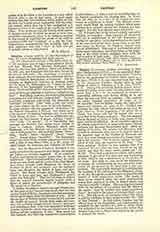

Caiphas (CAIAPHAS), JOSEPH, according to Josephus (Antiquitates, XVIII, iv, 3) was appointed High-Priest of the Jews by the Roman procurator Valerlus Gratus, the predecessor of Pontius Pilate, about A.D. 18 (Ant., XVIII, ii, 2), and removed from that office by the procurator Vitellius, shortly after he took charge of affairs in Palestine, A.D. 36 (Ant., XVIII, iv, 3). During this period the famous Annas, father-in-law of Caiphas (John, xviii, 13), who had been high-priest from A.D. 6 to 15, continued to exercise a controlling influence over Jewish affairs, as he did when his own sons held the position. This explains the rather puzzling expression of Luke, iii, 2, epi archiereos Anna kai Kaiapha (under the high-priest Annas and Caiphas; cf. Acts, iv, 6). Caiphas was certainly the only official high-priest at the time St. Luke refers to, at the beginning of the public life of Christ; but Annas still had his former title and a good deal of his former authority. The role assigned him in the trial of Christ, in John, xviii, points to the same continued influence. In the measures taken by the Jewish authorities to do away with Jesus, Caiphas certainly had the most discreditable part. After the raising of Lazarus, the priests and Pharisees held counsel to determine what was to be done in view of the manifest signs of the Prophet of Nazareth and what they were pleased to consider the danger resulting to the country. The words of Caiphas, the high priest of that year, are reported by St. John: “You know nothing. Neither do you consider that it is expedient for you that one man should die for the people, and that the whole nation perish not” (xi, 49-50). They show a disdain for others, and a determination to get rid of this man who was displeasing to him, without any consideration of the justice of his cause. But while we may see in the declaration of Caiphas the manifestation of very unworthy sentiments, we are warned by St. John that it was prophetical. The high-priest expressed in a striking way the meaning of the sufferings of the Man–God (John, xi, 51, 52), though he could not have realized the full import of those mysterious words. The death of Jesus being resolved upon, the most unscrupulous means were employed in order to bring it about, and Caiphas is chiefly to blame. The meeting determined upon by the princes of the priests and the elders of the people, “that by subtilty they might apprehend Jesus”, was held in the house of Caiphas (Matt., xxvi, 3-5). The hill south of Jerusalem where this house is said by tradition to have stood is called the “Hill of Evil Counsel” As high-priest, Caiphas was the official head of the Sanhedrin, and consequently responsible for the travesty of a trial to which Christ was submitted by the Jewish authorities, before they handed Him over to Pilate and stirred up the people ‘to demand His death.
After the death of Jesus, Caiphas continued to persecute His followers. When Peter and John were brought before the Council after the cure of the lame man at the Beautiful Gate of the Temple (Acts, iv, 6 sqq.), Caiphas was still high-priest, since he was removed only in A.D. 36 or 37. We can say with almost equal certainty that he was the high-priest before whom St. Stephen appeared (Acts, vii, 1), and that it is from him that Saul obtained letters authorizing him to bring the Christians of Damascus to Jerusalem (Acts, ix, 1-2). At a time when high-priests were made and unmade at will by the officials of Rome, and when the principal quality required seems to have been subserviency, it is no credit to the character of Caiphas to have enjoyed their favor so long. Josephus mentions his removal in connection with a series of acts of Vitellius which were agreeable to the Jews. We are not told what became of him after his deposition.
W. S. REILLY

